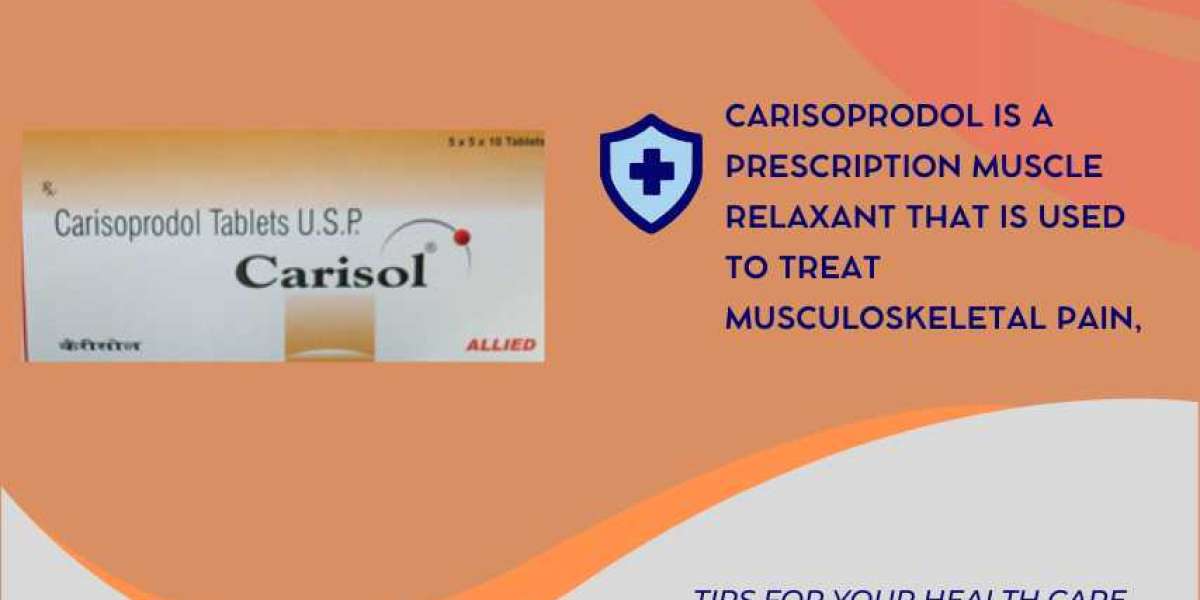Backline muscle pain is one of the most common complaints among adults, whether caused by physical strain, poor posture, or an underlying musculoskeletal condition. For those dealing with acute pain and stiffness, finding an effective treatment option is critical. Among the available medications, Carisoprodol, an FDA-approved muscle relaxant, has gained popularity for its ability to provide relief from backline muscle pain.
In this blog, we’ll discuss Carisoprodol’s FDA approval, how it works, its benefits for backline pain relief, and considerations for safe use.
What Is Carisoprodol?
Carisoprodol is a prescription medication primarily used to relieve discomfort associated with acute musculoskeletal conditions such as backline muscle pain, strains, or spasms. It is often prescribed for short-term use, typically a few days to a few weeks, as part of a comprehensive treatment plan that may also include rest, physical therapy, and other interventions.
This medication is commonly sold under the brand name Soma and was approved by the U.S. Food and Drug Administration (FDA) in 1959 for its effectiveness in relieving muscle pain.
How Does Carisoprodol Work?
Carisoprodol belongs to a class of drugs known as skeletal muscle relaxants. It works by influencing the central nervous system (CNS) rather than directly targeting the muscles. Specifically, it alters the communication between nerves in the spinal cord and the brain to block pain signals and relax muscle tension.
When muscles become overworked or injured, they often tighten or spasm, leading to pain and restricted movement. Carisoprodol helps by:
- Relaxing tight muscles: Reducing involuntary muscle contractions and easing tension.
- Blocking pain signals: Interrupting the transmission of discomfort from the affected muscles to the brain.
This dual mechanism provides both pain relief and improved mobility, allowing patients to engage in daily activities more comfortably.
FDA Approval: What It Means for Patients
The FDA’s approval of Carisoprodol underscores its safety and efficacy when used as prescribed. Before granting approval, the FDA evaluates a drug through rigorous clinical trials to ensure it meets specific standards. For Carisoprodol, this means:
- It is proven effective in alleviating acute musculoskeletal pain, including backline muscle pain.
- It has a well-understood safety profile, with common side effects and risks outlined for prescribers and patients.
- It is intended for short-term use, as long-term use can lead to dependence and other complications.
Patients using FDA-approved medications like Carisoprodol can have confidence in the drug’s quality, as it meets strict manufacturing and safety standards.
Benefits of Carisoprodol for Backline Muscle Pain Relief
Carisoprodol is particularly effective for individuals suffering from acute backline pain caused by muscle strain, tension, or spasms. Below are the primary benefits:
1. Quick Onset of Relief
Carisoprodol is fast-acting, with many patients experiencing pain relief within 30 minutes to 1 hour of taking the medication. Its effects last approximately 4 to 6 hours, making it suitable for managing pain throughout the day.
2. Muscle Relaxation
Backline pain often results from tight or spasming muscles. Carisoprodol helps relax these muscles, reducing discomfort and improving the range of motion.
3. Improved Sleep
Nighttime backline pain can disrupt sleep and prolong recovery. By relieving muscle tension, Carisoprodol can help patients sleep more comfortably.
4. Enhances Rehabilitation
When combined with physical therapy, Carisoprodol can help patients regain strength and flexibility by reducing pain and making exercises more manageable.
Common Uses of Carisoprodol
Carisoprodol is FDA-approved for the treatment of acute musculoskeletal pain, making it an excellent choice for various backline issues, including:
- Lower back pain: Strains caused by heavy lifting, sudden movements, or prolonged sitting.
- Upper back pain: Muscle stiffness or tension due to poor posture or repetitive stress.
- Sports injuries: Muscle strains or spasms resulting from overexertion.
- Workplace injuries: Pain from physical labor or awkward movements.
Considerations for Safe Use
While Carisoprodol is effective, it’s essential to use it responsibly to minimize risks and maximize benefits. Here are some key considerations:
1. Short-Term Use Only
Carisoprodol is intended for short-term use, typically no longer than 2-3 weeks. Prolonged use can lead to tolerance, meaning the body becomes less responsive to the drug, and dependence, where the patient may feel unable to function without it.
2. Potential Side Effects
Like all medications, Carisoprodol has potential side effects, though they are generally mild and manageable. These may include:
- Drowsiness
- Dizziness
- Headaches
- Nausea
It’s crucial to avoid activities requiring alertness, such as driving or operating heavy machinery, until you know how Carisoprodol affects you.
3. Interactions with Other Substances
Carisoprodol can interact with other medications, including pain relievers, sedatives, and alcohol. These interactions can enhance drowsiness or other side effects, so it’s vital to inform your doctor about any medications or supplements you’re taking.
4. Risk of Dependence
Carisoprodol has a potential for misuse or dependency, particularly in individuals with a history of substance abuse. Physicians carefully monitor its use to reduce these risks.
Who Should Avoid Carisoprodol?
While Carisoprodol is effective for many people, it’s not suitable for everyone. The following groups should avoid the medication or use it under close medical supervision:
- Pregnant or breastfeeding individuals: Limited studies exist on the safety of Carisoprodol during pregnancy or lactation.
- Individuals with a history of substance abuse: Carisoprodol can be habit-forming.
- Patients with certain medical conditions: Those with liver or kidney disease may require adjusted doses or alternative treatments.
Combining Carisoprodol with Other Treatments
To achieve the best results, Carisoprodol is often used as part of a comprehensive treatment plan, including:
- Physical therapy: Exercises to strengthen back muscles and improve posture.
- Rest: Allowing the backline muscles time to heal.
- Pain management techniques: Nonsteroidal anti-inflammatory drugs (NSAIDs) or heat and ice therapy can complement Carisoprodol’s effects.
- Postural corrections: Learning proper ergonomics and body mechanics can prevent future backline issues.
Conclusion
Carisoprodol is an FDA-approved medication that offers effective relief from acute backline muscle pain. Its ability to relax muscles and block pain signals makes it a valuable tool for managing discomfort caused by muscle spasms, strains, or tension. However, it is essential to use the medication responsibly and only as directed by a healthcare provider.
By understanding how Carisoprodol works and incorporating it into a broader treatment plan, patients can achieve significant relief from backline pain and get back to their daily lives with improved comfort and mobility. If you’re experiencing backline muscle pain, consult your doctor to see if Carisoprodol is the right option for you.











